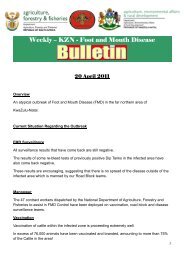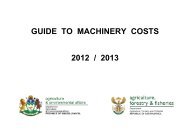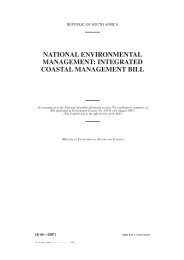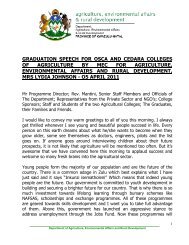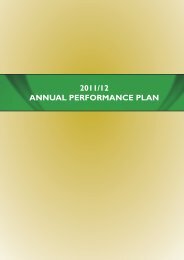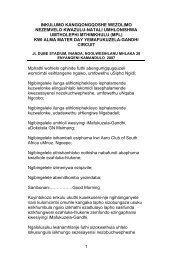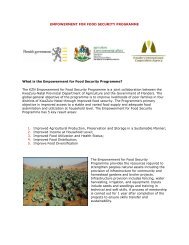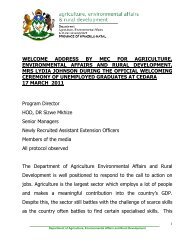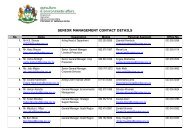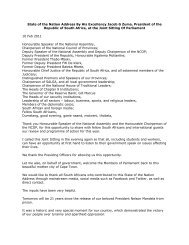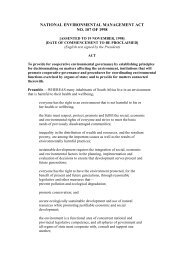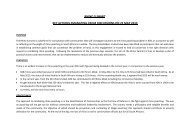Socio-Economic Report - Department of Agriculture and ...
Socio-Economic Report - Department of Agriculture and ...
Socio-Economic Report - Department of Agriculture and ...
You also want an ePaper? Increase the reach of your titles
YUMPU automatically turns print PDFs into web optimized ePapers that Google loves.
UDM ENVIRONMENTAL MANAGEMENT FRAMEWORK<br />
should strive to open communication channels with the private sector as well so that<br />
long-term lease <strong>and</strong> development agreements can be the stimulus for growth.<br />
DEMOGRAPHICS<br />
Demographic analysis aims to underst<strong>and</strong> the community, the population dynamics<br />
<strong>and</strong> the living conditions. Data from Community Survey 2007, Census 2001 <strong>and</strong><br />
Quantec Research will used to develop this underst<strong>and</strong>ing.<br />
POPULATION<br />
Using Statistics South Africa data presented in Table 4, the population for UDM in<br />
2001 was 573 341 persons which increased to 614 046 in 2007. Households during<br />
this period increase from 25 959 in 2001 to 27 006 in 2007.<br />
Jozini LM has the largest population <strong>of</strong> 207 250 persons. This is followed by<br />
Umhlabuyalingana LM where the population rose from 140 98 to 163 694 during the<br />
period. Conversely, Hlabisa LM, with the third largest population had declined over<br />
the period from 176 890 to 150 557 persons. Despite this decline in population, the<br />
number <strong>of</strong> households in Hlabisa has increased from 26 876 in 2001 to 38 260 in<br />
2007.<br />
The uMkhanyakude SDF reports the population growth rate to be 1.65 percent in<br />
comparison to South Africa’s population growth rate <strong>of</strong> 2.7 percent. The SDF states<br />
that this growth rate is affected by HIV/AIDs which has raised the death rate.<br />
Migration <strong>and</strong> urban bias are also contributing factors to low population growth.<br />
(Isikhungusethu Environmental Services (Pty) Ltd, 2008).<br />
Table 4 Population Statistics <strong>of</strong> UDM (Stats SA, 2001) (Statistics South Africa, 2007)<br />
Municipality<br />
Average Household<br />
Persons<br />
Households<br />
Size<br />
Census<br />
Census<br />
Census<br />
CS 2007<br />
CS 2007<br />
CS 2007<br />
2001<br />
2001<br />
2001<br />
Umhlabuyalingana -<br />
KZN271<br />
140 958 163 694 25 959 27 006 5.3 6.0<br />
Jozini - KZN272 184 052 207 250 33 534 38 530 5.4 5.3<br />
The Big Five False<br />
Bay - KZN273<br />
31 291 34 991 6183 6 657 48 5.2<br />
Hlabisa - KZN274 176 890 150 557 26876 29 260 6.5 5.1<br />
Mtubatuba - KZN275 33 612 46 596 7472 11 339 4.2 4<br />
DMA27 65 38 10 958 1539 2 181 4.1 4.6<br />
uMkhanyakude 573 341 614 046 101563 114 973 5.5 5.3<br />
The household sizes for the region are also provided for in the table above. There<br />
has been a marginal decline in household size for Jozini from 5.5 persons to 5.3.<br />
Umhlabuyalingana LM has the highest average household size <strong>of</strong> 6 persons in<br />
contrast to Mtubatuba LM with 4 persons per household.<br />
<strong>Socio</strong>-<strong>Economic</strong> Assessment Page 24



